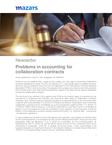
Problems in accounting for collaboration contracts
Sufficient are the problems that, in legal and tax matters, the new regime of business collaboration contracts established in Article 18 of the Tax Statute ("E.T.") has brought about. In addition to these, there are also the problems that arise from the application of the International Financial Reporting Standards ("IFRS") in their accounting. The purpose of this analysis is to review some of the problems that currently arise in this area and to evaluate their impact on the legal and tax regimes applicable to business collaboration contracts.
The first thing to be clarified in this regard is that IFRS do not mention types of contracts such as consortiums or temporary joint ventures, joint ventures or other types of collaboration contracts. Therefore, each contract must be analyzed according to its elements before it can be framed within a specific accounting standard. It is common for those accounting for transactions under a business collaboration contract to do so immediately as a joint arrangement, applying IFRS 11 or Section 15 of IFRS for SMEs. Before doing so, it should be noted that the only way in which it is possible to speak of a joint arrangement (under the modalities of joint operation or joint business) is that the parties, in the collaborative contract, actually exercise joint control, i.e., that they take - unanimously - the decisions related to it.
In order to determine the level of control that applies to the operation, and to determine whether there can be a joint agreement, it is necessary to carry out the following examination: Does only one of the participants make the decisions? If so, it would be a subsidiary (for the controlling party), as established by IAS 27 (IFRS 10) and the others would account for their investment there as an "Investment in Associates" -IFRS 28- (if, despite not having control, I have a percentage of the business that gives me "significant influence" in the decision making) or a simple financial instrument -IFRS 9- if my investment does not give me such "significant influence".
In the event that the nature of the business cannot be categorized as an investment for non-controlling parties, it would be a "principal and agent" or "customer-supplier" business (where there are simply commutative obligations to make and pay -IFRS 15-). The second question would be: In the collaboration contract -which must be in writing- do both parties make the decisions? If so, we would be dealing with a joint agreement, which may be a "joint business" or a "joint operation". While the joint venture is managed as an associate (where the investor will incorporate the profit or loss by the equity method), in the joint operation each participant will reflect in its balance sheet and in its income statement its participation in each of the accounts of the joint agreement.
However, as businesses move faster than regulatory developments, there may be situations that are problematic even for accounting purposes, and even more so if they are intended to be included in the tax regulations. It may be the case, for example, of a consortium where (due to a private agreement between the participants) only one of the consortium members is the one who makes all the decisions. In this case, for the controlling entity, such consortium (separate vehicle or structured entity) must be treated as a subsidiary (consolidating such equity in its financial statements) but, when applying article 18 of the E.T., it must indicate the percentage of income, costs, expenses, assets and liabilities that each party has according to the contract, which implies distorting fiscally such accounting reality.
The problem becomes even more acute with the joint account agreement, which should always be treated as a joint venture, but because decisions are not always made jointly or unanimously (because -almost always- the managing partner is autonomous in making them) such an agreement may not even be a joint arrangement, and should then be accounted for as a business between principal and agent where, when applying the revenue recognition rule, the principal should handle the gross value of the transactions (i.e., all revenues and all costs) and the agent should reflect only the net value of the transactions, i.e., only its commission.
And the issue is further aggravated when, by agreement between the parties, the hidden participant is the one who controls the operation (for example, by having a permanent veto over all the manager's decisions). In this case, in addition to there being no joint business, the manager should simply reflect in its accounting the net value of the transactions (its commission) and the hidden party should reflect the gross value of the transactions. And, at the moment of applying article 18 of the E.T., where it establishes that the administrator of the collaboration contract must certify to the other participants their participation in the income, costs, expenses, assets and liabilities, then it will be necessary that the manager goes to the hidden party to request such information, in order to be able to inform the parties - as manager - about it.


